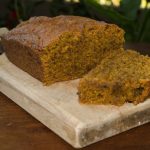
Japanese Pumpkin Bread
Ingredients
- 1-1/2 cups whole wheat Flour
- 1 teaspoon salt
- 1/2 cup coconut sugar
- 1 teaspoon baking soda
- 1 cup pureed Kabocha squash
- 1/4 cup coconut oil
- 1/4 cup mashed banana
- 2 Flax eggs (2 tblsp ground flaxseed, 1/2 cup of very hot water, see below)*
- 1/4 cup water
- 1/2 teaspoon nutmeg
- 1/2 teaspoon cinnamon
- 1/4 teaspoon ground cloves
Instructions
-
Preheat oven to 350*
-
Mix together flour, sugar, baking soda and salt
-
In a small bowl, mix flax egg ingredients, set aside
-
In a separate bowl, combine squash, oil, banana, flax eggs, water and spices
-
Add dry ingredients to the wet and stir until dry and wet ingredients are combined - do not over stir.
-
Pour into a greased loaf pan (9x5). Bake for 50-60 minutes. This loaf may not cook like a traditional bread. It stays very moist. When the top has a nice brown crust and an inserted toothpick comes out mostly clean, it's good to go!
-
The original recipe that I used was healthier than the norm, but when I made it the second day (that's right - we ate it all), I substituted a bit of a banana instead of oil and used less sugar for this healthier version. Also - I drastically reduced the sugar because the coconut oil lends some sweetness, along with the banana and this particular squash variety. The result of these substitutions is a very moist pumpkin-y bread.
* How to make Flax Eggs (or Chia Eggs)
-
Flax “eggs” are an easy substitute in most recipes calling for just one or two eggs. They’re a great option for vegans and those allergic to chicken eggs.
-
To prepare a flax egg, simply grind some flax seeds, or chia seeds, in a coffee grinder.
-
Note: Freshly ground seeds work best, over the store-bought milled variety.
-
For each egg, combine 1 tablespoon of ground flax seed (measure after grinding) with 3 tablespoons of water.
-
Stir well, and place in the fridge to set for 15 minutes.
-
After 15 minutes, the result should be a sticky egg-like substitute.
Recipe Notes
October 11, 2013 / New York Times